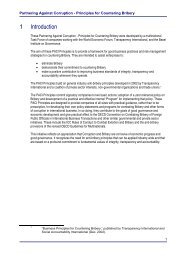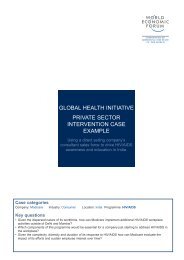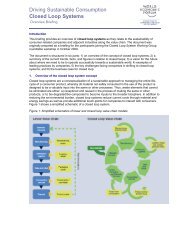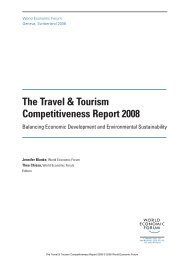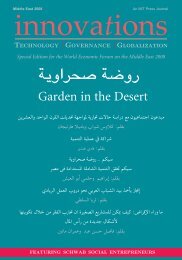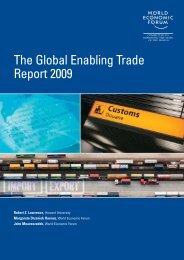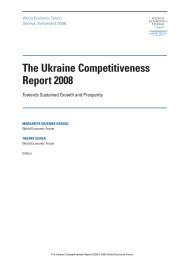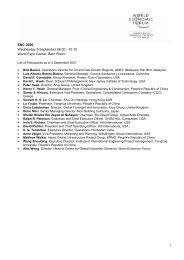The Travel & Tourism Competitiveness Report 2007 - World Economic ...
The Travel & Tourism Competitiveness Report 2007 - World Economic ...
The Travel & Tourism Competitiveness Report 2007 - World Economic ...
Create successful ePaper yourself
Turn your PDF publications into a flip-book with our unique Google optimized e-Paper software.
Executive Summary<br />
xxvi<br />
and return.<strong>The</strong> goal is to clarify how particular countries<br />
are perceived in this regard and to help them plan their<br />
strategy for decreasing risk, or increasing return, to make<br />
investment in the T&T environment more attractive in<br />
their respective countries.<br />
In “<strong>Tourism</strong> <strong>Competitiveness</strong> and the Development<br />
Agenda,” Geoffrey Lipman and John Kester of the<br />
UNWTO reflect on the potential of the TTCI to contribute<br />
to increasing the awareness of the importance of<br />
the tourism sector in global and national socioeconomic<br />
activity—especially for the world’s poorest countries.<br />
<strong>The</strong>y emphasize that by providing an overview of the<br />
factors driving the sector’s competitiveness, the Index<br />
will enhance tourism’s relevance for policymakers. Of<br />
particular interest is its potential for enhancing the competitiveness<br />
of the poorest countries and contributing to<br />
the Millennium Development Goals.<br />
Although the Index rankings make clear the great<br />
competitive advantages that industrialized states currently<br />
enjoy in this sector, as the authors explain this also implies<br />
a significant potential for improving the competitiveness<br />
of the poorest.Although low-income countries are generally<br />
characterized by a number of disadvantages, such<br />
as low skill levels, poor infrastructure, and poor transport<br />
services, they also have important comparative advantages,<br />
such as excellent natural and cultural attributes, relatively<br />
unspoiled environments that can be attractive for ecotourism,<br />
and abundant, low-cost labor. Further, tourism<br />
is growing rapidly in many developing countries.<strong>The</strong><br />
authors argue that the global development agenda obliges<br />
states to help proactively to reduce their disadvantages<br />
and enhance the comparative advantages.<br />
<strong>The</strong>y conclude with three recommendations. First,<br />
that there should be widespread adoption of the <strong>Tourism</strong><br />
Satellite Account (UNTSA) to ensure routine provision<br />
of data on the macroeconomic importance of the<br />
sector for policymaking. Second, that tourism should be<br />
integrated more explicitly into development processes<br />
—particularly by including the sector in national<br />
Poverty Reduction Strategy Papers and in the overall<br />
support strategies of international aid agencies.Third,<br />
they argue that, given tourism’s importance for developing<br />
countries, there is a window of opportunity for<br />
tourism services to be taken more explicitly into account<br />
in the Doha Development Round of trade negotiations,<br />
and that this opportunity should not be missed.<br />
In “Fulfilling the Promise: Positives and Potentials of<br />
<strong>Travel</strong> & <strong>Tourism</strong>,” Marilyn Carlson Nelson of Carlson<br />
examines the potential of <strong>Travel</strong> & <strong>Tourism</strong> to contribute<br />
positively to the world’s economies and societies, and<br />
explores whether the industry is living up to that<br />
potential.<br />
With regard to economic development, the author<br />
notes that developed economies already benefit fully<br />
from <strong>Travel</strong> & <strong>Tourism</strong>’s potential, as the industry there<br />
is mature, strong, and resilient. And in developing countries,<strong>Travel</strong><br />
& <strong>Tourism</strong> currently holds the promise of<br />
further development, as the industry is growing very<br />
rapidly. Further, developing countries also benefit greatly<br />
from indirect effects of the industry, such as the infrastructure<br />
development so often needed in developing<br />
nations, and the tax revenue that can be used for development<br />
purposes that it generates.<strong>The</strong> author also discusses<br />
how the benefits of <strong>Travel</strong> & <strong>Tourism</strong> go beyond<br />
economic development. She explains, for example, that<br />
since the industry depends on a destination’s attractions<br />
and culture, it is in its interest to work for their preservation,<br />
creating an agenda of sustainability.<strong>Tourism</strong> also<br />
promotes improved cultural understanding among nations.<br />
Nelson also highlights a number of challenges that<br />
remain to developing the sector and fulfilling its promise.<br />
<strong>The</strong>se include security concerns, hostile regulatory environments,<br />
difficulties in attracting and retaining quality<br />
employees, legislation hindering the hiring of immigrant<br />
labor, and gender inequality in management. As well as<br />
challenges, she also explores a number of opportunities<br />
that exist, such as sharing best practices, building publicprivate<br />
partnerships, and practicing corporate social<br />
responsibility.<br />
<strong>The</strong> author concludes by noting that although <strong>Travel</strong><br />
& <strong>Tourism</strong> has accomplished much, and although it still<br />
holds much promise, it requires commitment and action.<br />
Specifically, governments must have a clear strategy, and<br />
they must work together with industry leaders to seek<br />
out barriers to tourism development and address them.<br />
In his chapter “Electronic Payments: A Catalyst for<br />
<strong>Tourism</strong> and <strong>Economic</strong> Growth,” John Elkins of Visa<br />
International discusses how electronic payments have<br />
been an important driver of tourism in recent years. He<br />
also outlines the role that electronic payments will play<br />
in less-developed economies moving forward and how<br />
this will impact the T&T industry.<br />
<strong>The</strong> chapter begins with an overview of some of<br />
the critical challenges facing the growth of the T&T<br />
industry in developing and less-developed economies—<br />
such as poor communication and transportation infrastructure,<br />
legal uncertainties over ownership, high taxes,<br />
and bureaucratic obstacles to business. It then puts forward<br />
some broad approaches that can be implemented<br />
to increase global T&T spending as well as improve<br />
access to this important source of wealth creation and<br />
growth.Approaches covered include potential government<br />
actions, the need for public and private organizations to<br />
act in partnership, the importance of the development<br />
of mobile commerce for all economies, and the need to<br />
shape a new mindset (within both government and the<br />
private sector) that recognizes the value of tourism as a<br />
spur to development.<br />
Elkins goes on to highlight the great potential of<br />
electronic payments as a driver of economic development<br />
and an enabler of tourism growth. As he points out,<br />
payment cards and other electronic payment enablers are<br />
ubiquitous, secure, reliable, and convenient, and they<br />
make it easier for people to conduct business and easier



